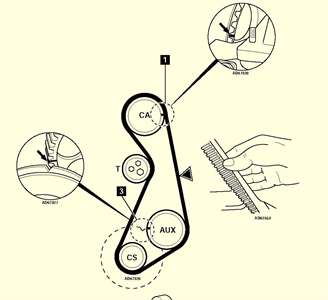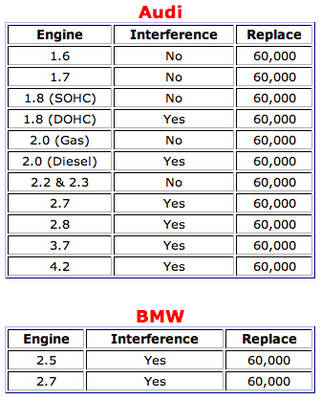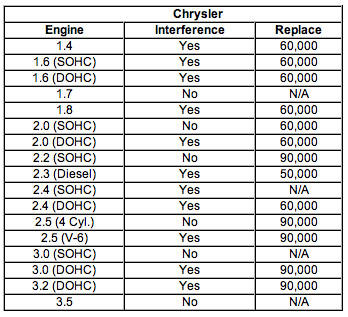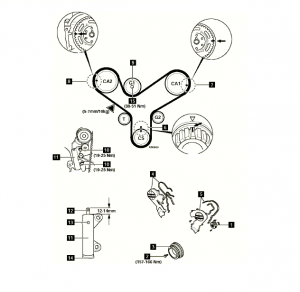Here is the timing diagram i think you are looking for Sue if not please get back to me or Joel one of us will be on line .
how do you line up the timing belt on a 84 audi 4000s1.8


Replace Your Timing Chain
What you will need:
1. Combination Wrenches
2. A Socket Set
3. Torque Wrench
3. A Harmonic Balancer Puller
5. A Three-jaw Gear Puller
6. Screwdrivers
7. Hammer and Punch
8. Gasket Scraper
9. Timing Light
10. Tube of Silicone Sealer
11. Timing Chain Cover Gasket Set
12. New Timing Chain and Gears
13. Drain Pan
14. Antifreeze
15. Jack
16. Jack stands
Before You Start:
Follow these instructions carefully. Read and be sure you understand them before you begin.
Gather together all of your tools and supplies before you begin.
Allow plenty of time to do the job so you don’t have to hurry.
Remember that these are general instructions. For more detailed instructions pertaining to your specific vehicle, consult an appropriate repair manual.
Safety is important whenever you’re working around machinery. Beware of hot objects, sharp instruments and hazardous materials.
Don’t substitute tools unless you’re sure you won’t compromise either your safety or the performance of your vehicle.
Never work on a vehicle that is only supported by a jack. Use jack stands to support the vehicle while you work. Work on a solid, level surface. Never jack a car up on dirt or grass.
Why Replace Your Timing Chain?
Over time, wear on internal working parts of your engine will spell the need for replacement. One of the internal working parts that wear is the timing chain and timing sprockets. The timing chain and sprockets are the connecting line between the crankshaft and the camshaft. As the crankshaft turns, via the timing chain, it drives the camshaft that operates the engine’s valves via the lifters, push rods and rocker arm assemblies The timing of the valves opening and closing at precise intervals is crucial for proper engine operation. As the timing chain and sprockets wear, this precise timing of the valves gradually changes, eventually to a point where replacement is necessary.
Telltale signs of worn out timing chains are:
Rough idle.
Sluggish performance and poor economy.
Sudden engine performance change including the inability to start the engine.
Intermittent backfire through the intake manifold.
Inconsistent ignition timing or a clattering noise coming from the front of the engine.
Before starting the disassembly procedures, I would suggest cleaning the engine with an engine degreaser. A clean engine is easier to work on and helps prevent dirt or contamination from entering the engine during disassembly.
Differen types of car engines
Engine to a car is like a heart to a human person. It functions by the principle of combustion or burning the fuel. There are different methods of classifying car engines. This classification is usually done according to the number of cylinders, the type of fuel used, and the arrangement of cylinders.
Type of fuel used
A car engine may either use petrol (gasoline) or diesel. Petrol engines use spark plugs for ignition. Diesel engines on the other hand use compression for ignition. The diesel engine is quite heavier than the gasoline engine. The gasoline (petroleum) engines are more common than diesel engines.
Number of cylinders
A car engine can have from three to twelve cylinders. The number of cylinders affects the power of the car. An eight-cylinder engine would be more powerful than a four-cylinder engine, though it would also consume a lot more fuel.
Arrangement of cylinders
In a car engine, you will find the cylinders are usually arranged in one of two ways. The cylinders could be inclined in a “V” shape or in a straight row. In that case, V-8 engine is an engine with eight cylinders inclined in a V shape. The earliest form of engine was known as the rotary cylinder engine. The cylinders in a rotary engine are arranged in a round manner with the crankshaft surrounded by a revolving block of cylinders. However, the rotary engines are quite rare today.
Other classifications
Engines may also be classified as to how they cool. A car may either use liquid coolant or air coolant. A car engine may also be classified according to the number of strokes, that is, four stroke, eight stroke and so on. Final thing to add here is that car engines can also have either a timing chain or a timing belt. Timing belt serves to regulate the timing of the valves of the engine. Timing chains may last longer than timing belts as they do not stretch and wear out due to tension.
Timing Belt Tech Data and Replacement Intervals for Acura
Your timing belt should be replaced every 50-70,000 miles. Carmakers have specified the replacement intervals for timing belts. In this database you will find these timing belt replacement intervals along with a little technical information regarding the valve configuration – interference or non-interference. In an interference engine, the valves and piston share the same air space. They never touch, unless your timing belt breaks or skips, and this is a catastrophic failure that requires removing the head and replacing bent valves. Non-interference engines do not risk this contact if the timing belt goes. Nonetheless, either can leave you stranded, so regular timing belt replacement is very important.
Be sure to replace your timing belt at the required intervals for your Acura. Timing belt replacement is crucial to the life of your engine. Interference type engines can suffer expensive damage in the case of timing belt failure. Bent valves are not cheap to replace! Below are the timing belt maintenance intervals and info for Acura cars.
Audi Timing Belt Tech Data and Replacement Intervals
Your timing belt AUDI should be replaced every 50-70,000 miles. Carmakers have specified the replacement intervals for timing belts. In this database you will find these timing belt replacement intervals along with a little technical information regarding the valve configuration – interference or non-interference. In an interference engine, the valves and piston share the same air space. They never touch, unless your timing belt breaks or skips, and this is a catastrophic failure that requires removing the head and replacing bent valves. Non-interference engines do not risk this contact if the timing belt goes. Nonetheless, either can leave you stranded, so regular timing belt replacement is very important.

Be sure to replace your timing belt at the required intervals for your Audi. Timing belt replacement is crucial to the life of your engine. Interference type engines can suffer expensive damage in the case of timing belt failure. Bent valves are not cheap to replace! Below are the timing belt maintenance intervals and info for Audi cars.
Chrysler Timing Belt Tech Data and Replacement Intervals
Your timing belt should be replaced every 50-70,000 miles. Carmakers have specified the replacement intervals for timing belts. In this database you will find these timing belt replacement intervals along with a little technical information regarding the valve configuration – interference or non-interference. In an interference engine, the valves and piston share the same air space. They never touch, unless your timing belt breaks or skips, and this is a catastrophic failure that requires removing the head and replacing bent valves. Non-interference engines do not risk this contact if the timing belt goes. Nonetheless, either can leave you stranded, so regular timing belt replacement is very important.

Be sure to replace your timing belt at the required intervals for your Chrysler. Timing belt replacement is crucial to the life of your engine. Interference type engines can suffer expensive damage in the case of timing belt failure. Bent valves are not cheap to replace! Below are the timing belt maintenance intervals and info for Chrysler cars.
Daihatsu and Daewoo Timing Belt Tech Data and Replacement Intervals
Your timing belt should be replaced every 50-70,000 miles. Carmakers have specified the replacement intervals for timing belts. In this database you will find these timing belt replacement intervals along with a little technical information regarding the valve configuration – interference or non-interference. In an interference engine, the valves and piston share the same air space. They never touch, unless your timing belt breaks or skips, and this is a catastrophic failure that requires removing the head and replacing bent valves. Non-interference engines do not risk this contact if the timing belt goes. Nonetheless, either can leave you stranded, so regular timing belt replacement is very important.

Be sure to replace your timing belt at the required intervals for your Daewoo or Daihatsu. Timing belt replacement is crucial to the life of your engine. Interference type engines can suffer expensive damage in the case of timing belt failure. Bent valves are not cheap to replace! Below are the timing belt maintenance intervals and info for Daewoo or Daihatsu cars.
Ford Timing Belt Tech Data and Replacement Intervals
Your timing belt should be replaced every 50-70,000 miles. Carmakers have specified the replacement intervals for timing belts. In this database you will find these timing belt replacement intervals along with a little technical information regarding the valve configuration – interference or non-interference. In an interference engine, the valves and piston share the same air space. They never touch, unless your timing belt breaks or skips, and this is a catastrophic failure that requires removing the head and replacing bent valves. Non-interference engines do not risk this contact if the timing belt goes. Nonetheless, either can leave you stranded, so regular timing belt replacement is very important.

Be sure to replace your timing belt at the required intervals for your Ford. Timing belt replacement is crucial to the life of your engine. Interference type engines can suffer expensive damage in the case of timing belt failure. Bent valves are not cheap to replace! Below are the timing belt maintenance intervals and info for Ford cars.
Geo Timing Belt Tech Data and Replacement Intervals
Your timing belt should be replaced every 50-70,000 miles. Carmakers have specified the replacement intervals for timing belts. In this database you will find these timing belt replacement intervals along with a little technical information regarding the valve configuration – interference or non-interference. In an interference engine, the valves and piston share the same air space. They never touch, unless your timing belt breaks or skips, and this is a catastrophic failure that requires removing the head and replacing bent valves. Non-interference engines do not risk this contact if the timing belt goes. Nonetheless, either can leave you stranded, so regular timing belt replacement is very important.

Be sure to replace your timing belt at the required intervals for your Geo. Timing belt replacement is crucial to the life of your engine. Interference type engines can suffer expensive damage in the case of timing belt failure. Bent valves are not cheap to replace! Below are the timing belt maintenance intervals and info for Geo cars.

